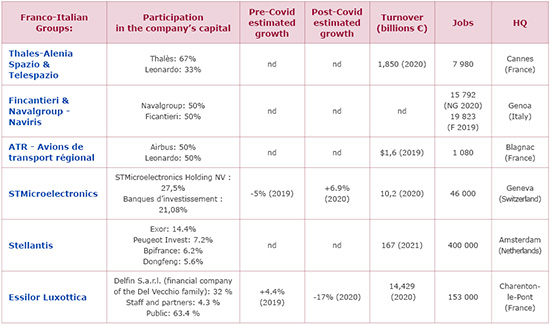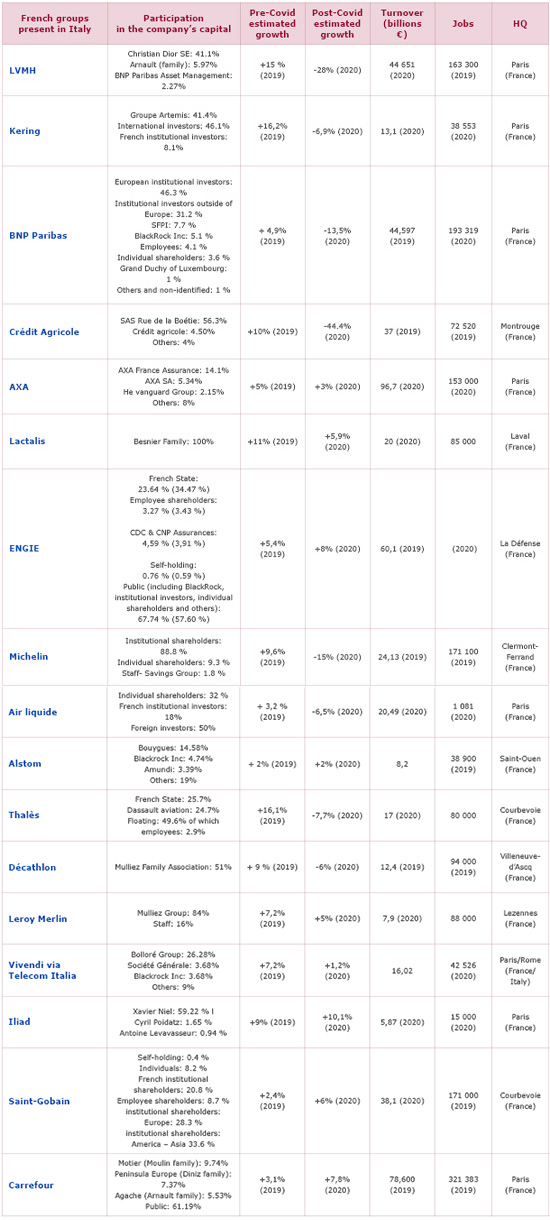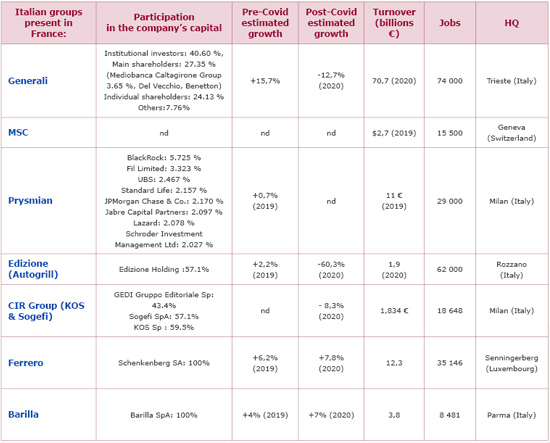Member states
Gilles Gressani
-

Available versions :
EN
Gilles Gressani
Leonardo da Vinci, Mazarin, Dalida ... Since the Renaissance, and with astonishing continuity, the Franco-Italian connection has become a given in European history.
The two States are shaped by similar political models and have comparable economic structures. They have experienced similar social crises, trajectories and a homogeneous sense of decline[1]. France, Italy's leading investor and third largest country for the establishment of Italian subsidiaries, is Italy's second largest trading partner and Italy is France's second largest trading partner: in 2019, before the Covid crisis, the volume of trade between the two countries was close to €90 billion. The interconnection and proximity between a significant share of the two populations is expressed by language, a certain lifestyle, the relationship to heritage, a common culture: Latin, Mediterranean, European. Reflecting on the relations between these two areas since the 17th century, three historians have recently taken up this old idea: France and Italy are "two sister nations" whose history is increasingly "intertwined[2]".
This proximity, which seems so obvious, brings a paradox to the fore. Can we really say that within the framework of European integration there is a Franco-Italian dimension, in the same way as there is one that is Franco-German?
If we focus solely on the last five years, we have to admit that the relationship between the two States has been extremely volatile. Mutual distrust and deep misunderstandings have led to dramatic breakdowns, the most spectacular of which was undoubtedly the recall to Paris of the French ambassador in Rome on 7 February 2019, a unique case in the recent history of these two founding Member States of the European Union.
Since this diplomatic incident, the French president, Emmanuel Macron, and his Italian counterpart, Sergio Mattarella, have engaged more intensely in a process of rapprochement[3], marked by a series of bilateral meetings (in Chambord in May 2019; in Naples in February 2020, for the 35th Franco-Italian summit). This sequence, supported by the infrastructure of a two State summit should lead, by the end of the year, to the adoption of a bilateral treaty called the "Treaty of the Quirinal". The choice of the Roman palace, the residence of the President of the Italian Republic since 1948, is an explicit reference to the Élysée Treaty, signed in Paris in 1963, at a key moment in the Franco-German rapprochement.
This text aims to suggest some keys of understanding the political and institutional logic underlying the serious breakdowns in Franco-Italian relations in 2018-2019, as well as the re-set around the Treaty of the Quirinal - which, under the catalytic influence of Mr Draghi, constituted an important moment[4] - based on a comparative reading of the depth of the Franco-German relationship. By trying to explain the asymmetry that regulates the Franco-Italian relationship, grounded on the paradox of their proximity, it proposes to give a new centrality to this Franco-Italian axis, necessary for a deeper geopolitical integration of the European Union.
1. The Franco-Italian relationship in the shadow of Franco-German relations
Since the end of the Second World War[5], the Franco-German link appears to have become the symmetrical axis of the Franco-Italian one. While the proximity between France and Italy seemed as obvious as it was immediate, the Franco-German friendship was never guaranteed. It even seemed impossible to conceive, such was the deep rupture between the two countries, such was their hostility that seemed 'hereditary', their differences being exacerbated by the creation of their respective national identities[6]. It is precisely this seemingly insurmountable gap that was at the origin of the profound structuring effort that led to a rapprochement between the two States.
Since the Schuman Declaration on 9th May 1950[7], and the twinning projects started in the 1950s, the 1963 Élysée Treaty[8] and the creation of bi-national institutions such as the Franco-German Youth Office[9], the rapprochement between Germany and France has been achieved in an incremental way - according to Schuman's famous formula - "through concrete achievements that first create de facto solidarities." The Franco-German couple is in fact the priority pillar, the keystone of European integration because it has led to the elimination of what is perceived as the main threat to its achievement: "the age-old opposition of France and Germany[10]".
In the geopolitical context of the confrontation between the USSR and the United States, the reconciliation of the French Republic with the Federal Republic of Germany confirmed the conceptual framework of the Schuman Declaration, contributing to the construction of a Western European bloc that was coherent with the Atlantic Alliance, capable of developing and being victorious in the medium term. In this paradigm, the Franco-Italian relationship is a secondary one that plays within a derivative dimension. If we look at this, one might almost be tempted to consider the counterfactual history of continental integration beginning with the Franco-Italian framework built on a non-aligned 'Latin Europe', following the course outlined in a report written in 1945 by one of Europe's most elusive founding fathers, Alexandre Kojève[11].
The stability of this geopolitical configuration has since resisted a certain loss of momentum caused, among other things, by the general disarray of the end of the Cold War. In recent years, sometimes harsh criticism on the part of leading members of the French government (the Minister of the Economy in 2014 or the Prime Minister in 2016), institutional misunderstandings (over the question of the seat on the Security Council, the role of the Karlsruhe Court) as well as an increasingly obvious economic divergence, did not prevent the two countries from adopting the Treaty of Aachen in 2019 or from undertaking the Franco-German initiative for European recovery on 18 May 2020 to counter the health crisis, which formed the basis of the European Recovery Plan.
2. Asymmetry in Franco-Italian proximity
Through its institutions, networks and socialisation processes, the Franco-German relationship continues to play a key role. On the Franco-Italian side, the incapacity to establish points of convergence by the definition of stable frameworks for the negotiation of divergence has produced a paradoxically asymmetrical and deeply unstable relationship.
The mismatch in the representation of the relationship with the other may explain the frustration towards France felt in the Italian political debate and measured by opinion polls. As Marc Lazar explained in 2019: "There is an imbalance in our two relations, a feeling also that they are getting seriously worse. The French show sympathy and interest for Italy, while the Italians - at almost 38% - show antipathy for the French[12]". A French diplomat summed up this problem with a particularly powerful metaphor: "The Italians travel in third class with a second-class ticket, we travel in first class with the same ticket[13]".
This asymmetry is a constant in economic representations between the two countries. As can be seen from the annexed tables (see annexes 1-3), the capitalist systems of the two countries are deeply intertwined. However, alongside Franco-Italian political tensions, it is above all the processes of sectoral integration, such as the STX-Fincantieri project, which have become real media or political affairs in Italy, that fuel anti-French sentiment. Thus, several media or regular observers, sometimes even influential members of the Italian administration or services, adopt an interpretation of current events that sees the initiatives of French groups as a sort of new "Italian campaign" that would lead France to economic hegemony. This interpretation can be understood in terms of the economic history of the two countries in the 1990s. If the Italy of the vincolo esterno[14], proposing a response to the public finance crisis and the collapse of its political system, is privatising en masse, transforming the structure of its State-owned enterprises, "France is delaying the transposition of the various market liberalisation directives as long as possible so that it can maintain the structure of State-owned enterprises and internal monopolies as late as possible[15]" according to Jean-Pierre Darnis, who adds "it is in this context - two divergent timetables - that the structural conditions of non-cooperation between the two countries are created." This is a major problem, as asymmetry produces divergence, even when convergence would produce positive political effects for both countries.
3. The paradoxes of proximity
If the Franco-Italian relationship is so deeply marked by asymmetry, it is because it has not experienced continuous institutionalisation based on concrete elements that enable the creation of spaces or initiatives for socialisation or compromise. This is the crux of the paradox of proximity and the double pitfall it presents.
On the one hand, proximity can accentuate mechanisms of differentiation, by creating particularly divergent geopolitical representations from common elements. Gilles Pécout has shown how the geopolitical representation of the Mediterranean space is a place of confrontation in the corpus of the Risorgimento and in the irredentist claims on Nice and Corsica, taken up by the fascist regime[16]. The Turin philosopher of the Risorgimento, Vincenzo Gioberti, claimed in 1843 an Italian primacy over the Mediterranean against France: "The French are in the habit of assigning this privilege to their homeland, but the truth is that France participates in the centrality of civilisation in Europe only through Provence; because the Mediterranean [...] is the true centre, and so to speak the place of civilised peoples. And now the central point of the Mediterranean is occupied by Italy[17]".
On the other hand, more commonly, proximity creates the impression of immediacy, of ease: the relationship is left untouched, what is done spontaneously seems sufficient. There is not enough support for the effort of mutual understanding, initiatives or exchange programmes are still rare, such as language learning. Alain Finkielkraut expressed this paradox in an interview in 2017: "[Italian] is a beautiful European language that is not learned in France, often with the absurd idea that it is an easy language which, unlike Spanish, is not spoken on several continents. The result is that, when you go to Italy, you speak English with the Italians and it's heart-breaking, because it's an absolutely beautiful language[18]".
4. The Franco-Italian relationship is a fundamental pillar of geopolitical Europe
The Franco-Italian relationship still lacks an adequate common infrastructure to counter the asymmetry and fundamental misunderstandings that make it dysfunctional and accentuate processes of counter-productive divergence. However, as the ratification of the Quirinal Treaty approaches, signals of a new convergence (on Libya, on the revocation of the Mitterrand Doctrine) have appeared regarding some of the long-standing issues that were central to the misunderstanding between the two States.
This rapprochement is not superficial; it should not be considered in the rhetoric of Latin or cultural proximity. The scope of the European geopolitical project will depend on the solidity of its pillars, of which the Franco-Italian axis is an absolute bearer. Alessandro Aresu, adviser to Mario Draghi, rightly emphasised the geopolitical potential of closer economic integration between the two countries: "No industrial strategy on a bilateral or continental scale can work without a fabric of trust. Otherwise, resistance to integration will prevail and European markets will have no autonomous industrial government, they will be only one of the strategic arenas of the confrontation between the US and China[19]."
***
The paradigm of the beginning of European integration attributed to the Franco-German reconciliation an absolutely central and priority role: a necessary condition of the process that finally integrated Western Europe, contributing to the victory of the Atlantic axis. The question that must now be asked is: in the new geopolitical configuration, which seems increasingly to be moving towards a confrontation between the United States and China, what is the condition for the achievement of greater integration? In other words, what would the resistance to integration be? What would the weakest link be that might cause the European project to fail? According to Italian economist Andrea Capussela, "Italy and Europe will rise or fall together[20]". The Franco-Italian relationship offers indispensable convergence to rebalance the continental political and economic order.
The process that led to the adoption of the recovery plan shows this. As the French and Italian Ministers for European Affairs, Clément Beaune and Vincenzo Amendola, explained, the initiative for the common debt is first and foremost Franco-Italian: "Exactly one year ago, when Europe faced the first epidemic wave of Covid-19 with unprecedented socio-economic consequences, we proposed, on a Franco-Italian initiative, together with seven other European States to work on a common debt instrument[21]". Of course, German support for the initiative was crucial and the fear of a rupture of the Franco-German link undoubtedly convinced the Chancellor to use her political capital to get the principle of the Recovery Plan approved.
However, it seems increasingly clear that the structuring of a "web of trust", allowing France and Italy to understand the proximity of their views and interests, beyond resentment or asymmetrical representations, would allow the two countries to formulate the joint proposals that have become necessary to continue the process of integration on a continental scale on a better basis.



[1] Cf. The Ipsos survey for Sciences Po, Luiss Guido Carli and The European House Ambrosetti undertaken from 5 - 13 June 2019 amongst 1000 French citizens and 1000 Italians forming national representative samples of their national populations aged 18 and over.
[2] Gilles Bertrand, Jean-Yves Frétigné, Alessandro Giacone, La France et l'Italie. Histoire de deux nations sœurs de 1660 à nos jours, Paris Armand Colin, 2016
[3] It should be noted that the genealogy of the Treaty of the Quirinale precedes this sequence. According to one of the people at the heart of its conception: 'the idea of the Treaty dates from the Franco-Italian summit in Lyon (September 27, 2017) the day following the Sorbonne speech (September 26, 2017) which is not casual'. As Paolo Gentiloni indicates in his memoir (La ragione impopulista, Roma, Rizzoli, 2018), as early as January 2018 the French President and the President of the Italian Council signed the official mission letters that entrusted six people - sometimes referred to by the media as the "group of the wise" - with the elaboration of the first version of the text: on the Italian side, Paola Severino, Franco Bassanini, Marco Piantini, and on the French side, Sylvie Goulard, Pascal Cagni and Gilles Pécout.
[4] In his general policy speech to the Senate, Mario Draghi implicitly referred to the Quirinal Treaty when he said that his objective was to : "better structure our relations with France and Germany".Comunicazioni del Presidente Draghi al Senato, 17 February 2021. For a first analysis of the Draghi government in the Franco-Italian relationship see Jean-Pierre Darnis, Draghi et le monde : le retour de l'Italie hors de ses frontières, le Grand Continent, 27 April 2021.
[5] Corine Defrance, Ulrich Pfeil, Histoire franco-allemande, vol. 10: Entre guerre froide et intégration européenne. Reconstruction et rapprochement 1945–1963, Villeneuve d'Ascq, Septentrion, 2012.
[6] Anne-Marie Thiesse, La Création des identités nationales. Europe, 18e-20e siècle, Paris, Seuil, 1999.
[7] Andreas Wilkens (dir.), Le Plan Schuman dans l'histoire. Intérêts nationaux et projet européen, Brussels, Bruylant, 2004.
[8] Le Traité de l'Élysée et les relations franco-allemandes 1945 - 1963 - 2003, Paris, CNRS Éditions, 2005.
[9] Hans Manfred Bock, Corine Defrance, Gilbert Krebs et Ulrich Pfeil (éd.), Les jeunes dans les relations transnationales. L'Office franco-allemand pour la jeunesse 1963–2008, Paris, PSN, 2008.
[10] The Schuman Declaration 9 May 1950.
[11] Alexandre Kojève: "Esquisse d'une doctrine de la politique française" In : Hommage à Alexandre Kojève : 28 janvier 2003 Paris : Éditions de la Bibliothèque nationale de France, 2007.
[12] Mar Lazar, "Français et Italiens, quels sentiments réciproques ? Présentation de la deuxième session des Dialogues franco-italiens de Sciences Po et de la LUISS" June 2019.
[13] Private conversation with a French diplomat, 24 March 2021.
[14] Ben Judah, L'art du pouvoir en Europe, portrait de Mario Draghi, le Grand Continent, 16 May 2021.
[15] Jean-Pierre Darnis, Une vision stratégique des relations franco-italiennes : vers un traité bilatéral, Fondation pour la Recherche stratégique, 29 July 2020
[16] Gilles Pécout, "Pour une lecture méditerranéenne et transnationale du Risorgimento", Revue d'histoire du XIXe siècle, 44 | 2012, 29-47.
[17] Vincenzo Gioberti, Del Primato morale e civile degli italiani (1843), introduzione e note di Gustavo Balsamo-Crivelli, I, Torino, UTET, 1919, p. 42-43.
[18] Gilles Gressani, Mathéo Malik, "J'étais d'abord un patriote européen", a conversation with Alain Finkielkraut, le Grand Continent, 4 July 2017.
[19] Alessandro Aresu, "Pour une nouvelle intégration économique franco-italienne", le Grand Continent, 12 January 2021
[20] Andrea Capussela, L'Italie et l'Europe se développeront ou s'effondreront ensemble, Paris, Groupe d'études géopolitiques, Working Paper, May 2021.
[21] Article by MM. Clément Beaune et Vincenzo Amendola, La Croix, 25 March 2021
[22] The author thanks Mathieu Moiroud for his work on the tables.
Publishing Director : Pascale Joannin
On the same theme
To go further
Digital and technologies
Josef Aschbacher
—
9 December 2025
Democracy and citizenship
Florent Ménégaux
—
2 December 2025
Democracy and citizenship
Jean-Dominique Giuliani
—
25 November 2025
Strategy, Security and Defence
Amiral (2S) Bernard Rogel
—
18 November 2025

The Letter
Schuman
European news of the week
Unique in its genre, with its 200,000 subscribers and its editions in 6 languages (French, English, German, Spanish, Polish and Ukrainian), it has brought to you, for 15 years, a summary of European news, more needed now than ever
Versions :




